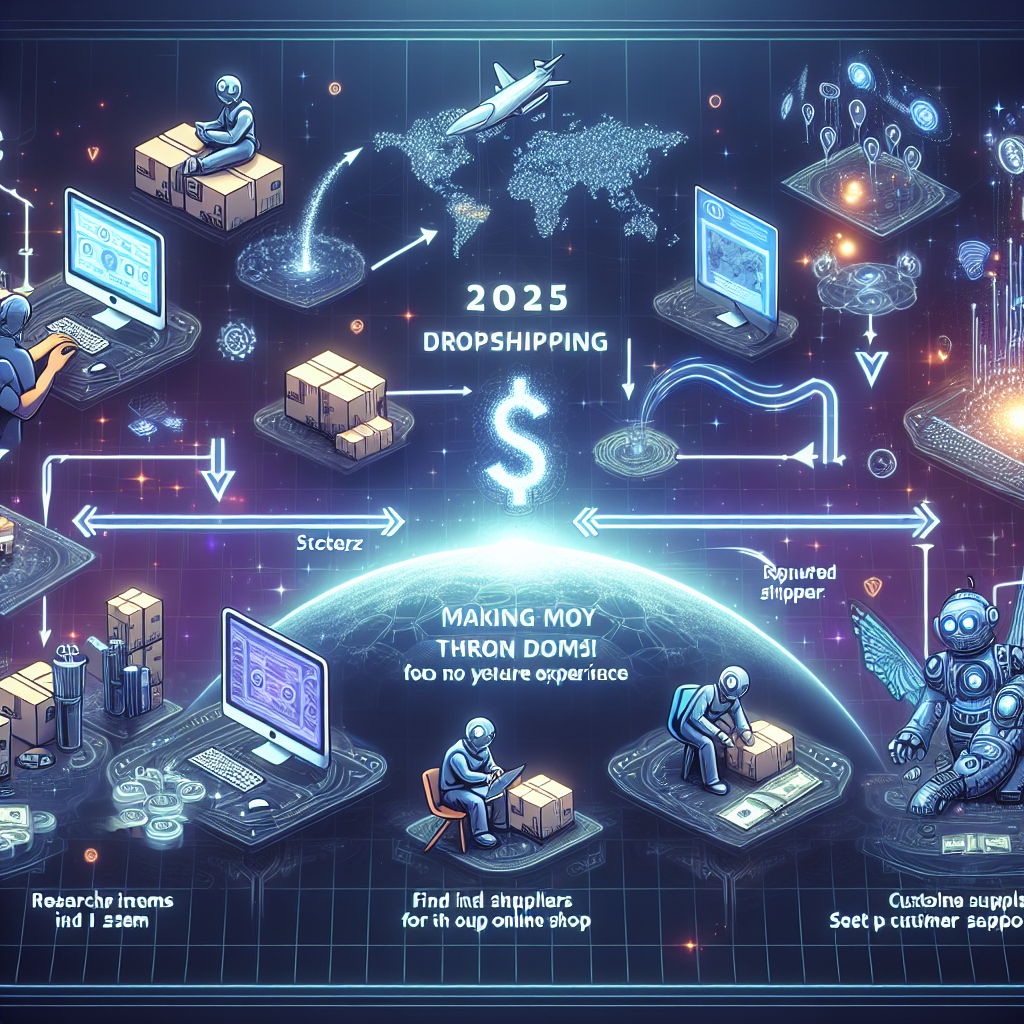-
Table of Contents
“Unlock Your 2025 Income: Master Dropshipping with Zero Experience!”
Introduction
In 2025, the digital marketplace continues to evolve, offering unprecedented opportunities for aspiring entrepreneurs to generate income with minimal upfront investment. One of the most accessible and potentially lucrative ventures is dropshipping, a business model that allows individuals to sell products online without holding any inventory. This guide, “How to Make Money in 2025: Dropshipping with Absolutely No Experience,” is designed to empower beginners with the knowledge and tools needed to succeed in this dynamic field. By leveraging cutting-edge e-commerce platforms, automation tools, and strategic marketing techniques, even those with no prior experience can tap into the global market, create a profitable online store, and achieve financial independence. Whether you’re looking to supplement your income or build a full-fledged business, this guide will provide you with a step-by-step roadmap to navigate the world of dropshipping in 2025.
Understanding the Basics: A Beginner’s Guide to Dropshipping in 2025
In 2025, the landscape of e-commerce continues to evolve, offering numerous opportunities for individuals to generate income with minimal upfront investment. One such opportunity is dropshipping, a business model that allows entrepreneurs to sell products without holding any inventory. This model has gained significant traction due to its low barrier to entry and potential for profitability. For those with no prior experience, understanding the basics of dropshipping is crucial to embarking on this entrepreneurial journey.
To begin with, dropshipping involves partnering with suppliers who handle the storage, packaging, and shipping of products directly to customers. This eliminates the need for the seller to manage inventory, thereby reducing overhead costs. The seller’s primary responsibility is to market the products and manage customer relationships. In 2025, technological advancements have further simplified this process, making it accessible even to those with no prior business experience.
The first step in starting a dropshipping business is selecting a niche. This involves identifying a specific market segment that aligns with your interests and has sufficient demand. Conducting thorough market research is essential to understand consumer preferences and identify trending products. Tools such as Google Trends and social media analytics can provide valuable insights into current market trends. Once a niche is selected, the next step is to find reliable suppliers. Platforms like AliExpress, Oberlo, and SaleHoo offer extensive directories of suppliers, making it easier to find partners who can provide quality products at competitive prices.
After securing a supplier, the next phase involves setting up an online store. In 2025, platforms like Shopify and WooCommerce offer user-friendly interfaces that allow individuals to create professional-looking websites without any coding knowledge. These platforms also integrate seamlessly with various payment gateways, ensuring secure transactions for customers. Additionally, they offer a range of customizable templates and plugins to enhance the functionality and aesthetics of the online store.
Marketing is a critical component of a successful dropshipping business. In 2025, digital marketing strategies have become more sophisticated, with social media platforms playing a pivotal role in reaching potential customers. Leveraging platforms like Instagram, TikTok, and Facebook can significantly boost brand visibility and drive traffic to your online store. Creating engaging content, utilizing influencer partnerships, and running targeted ad campaigns are effective ways to attract and retain customers.
Customer service is another vital aspect of dropshipping. Providing excellent customer support can differentiate your business from competitors and foster customer loyalty. Implementing chatbots and AI-driven customer service tools can enhance the customer experience by providing instant responses to inquiries and resolving issues efficiently.
Finally, it is important to continuously analyze and optimize your business operations. Utilizing analytics tools to track website traffic, conversion rates, and customer behavior can provide valuable insights into areas for improvement. Regularly updating your product offerings and marketing strategies based on these insights can help maintain a competitive edge in the dynamic e-commerce landscape.
In conclusion, dropshipping in 2025 offers a viable pathway to financial independence for individuals with no prior experience. By understanding the basics of this business model and leveraging the technological advancements available, aspiring entrepreneurs can successfully navigate the world of e-commerce. With dedication, strategic planning, and a customer-centric approach, dropshipping can be a rewarding venture in the ever-evolving digital marketplace.
Leveraging Technology: Essential Tools for New Dropshippers in 2025

In the rapidly evolving landscape of e-commerce, dropshipping has emerged as a popular business model, particularly for those seeking to enter the market with minimal upfront investment. As we look towards 2025, the integration of advanced technology has made it increasingly accessible for individuals with no prior experience to successfully launch and manage a dropshipping business. Leveraging the right tools is essential for new dropshippers to navigate this competitive environment effectively.
To begin with, selecting a reliable e-commerce platform is crucial. Platforms such as Shopify and WooCommerce have continued to dominate the market, offering user-friendly interfaces and comprehensive support systems. These platforms provide seamless integration with various dropshipping apps, allowing newcomers to easily set up their online stores. Moreover, they offer customizable templates and themes, enabling users to create a professional-looking storefront without the need for extensive design skills.
In addition to choosing an e-commerce platform, utilizing product sourcing tools is vital. Applications like Oberlo and Spocket have revolutionized the way dropshippers find and import products. These tools connect users with a vast network of suppliers, providing access to a wide range of products at competitive prices. Furthermore, they offer features such as automated order fulfillment and inventory management, which streamline operations and reduce the risk of human error.
As the digital marketplace becomes increasingly saturated, effective marketing strategies are essential for standing out. Social media platforms, including Instagram, TikTok, and Facebook, continue to be powerful channels for reaching potential customers. However, the landscape in 2025 demands a more sophisticated approach. AI-driven marketing tools, such as AdEspresso and Hootsuite, enable dropshippers to create targeted advertising campaigns with precision. These tools analyze consumer behavior and preferences, allowing for personalized marketing efforts that resonate with specific audiences.
Moreover, customer relationship management (CRM) systems have become indispensable for maintaining strong customer connections. Tools like HubSpot and Salesforce offer comprehensive solutions for managing customer interactions, tracking sales, and analyzing data. By leveraging these systems, dropshippers can enhance customer satisfaction and foster loyalty, which are critical components for long-term success.
Another essential aspect of dropshipping in 2025 is the use of analytics tools. Understanding consumer trends and behaviors is key to making informed business decisions. Google Analytics and similar platforms provide valuable insights into website traffic, user engagement, and conversion rates. By analyzing this data, dropshippers can identify areas for improvement and optimize their strategies accordingly.
Furthermore, the integration of artificial intelligence and machine learning has transformed the way dropshippers operate. AI-powered chatbots, for instance, have become a staple in customer service, providing instant support and resolving queries efficiently. This not only enhances the customer experience but also frees up valuable time for business owners to focus on other critical tasks.
In conclusion, while the prospect of starting a dropshipping business in 2025 may seem daunting to those with no experience, the availability of advanced technological tools has made it more accessible than ever. By leveraging e-commerce platforms, product sourcing applications, marketing tools, CRM systems, analytics platforms, and AI-driven solutions, new dropshippers can effectively navigate the complexities of the digital marketplace. As technology continues to evolve, staying informed and adaptable will be key to achieving success in this dynamic industry.
Marketing Strategies: How to Drive Traffic and Sales with Zero Experience
In the rapidly evolving landscape of e-commerce, dropshipping has emerged as a popular business model, especially for those seeking to enter the market with minimal upfront investment. As we look towards 2025, the potential for making money through dropshipping remains promising, even for individuals with no prior experience. The key to success lies in effective marketing strategies that drive traffic and sales. Understanding how to leverage these strategies can transform a novice into a successful entrepreneur.
To begin with, it is essential to recognize the importance of identifying a niche market. This involves researching and selecting a specific segment of the market that is not overly saturated but has a demand for products. By focusing on a niche, you can tailor your marketing efforts to a targeted audience, thereby increasing the likelihood of conversions. Once a niche is identified, the next step is to source reliable suppliers who can provide quality products at competitive prices. Establishing strong relationships with suppliers ensures a smooth supply chain, which is crucial for maintaining customer satisfaction and fostering repeat business.
With a niche and suppliers in place, the focus shifts to building an online presence. Creating a user-friendly and visually appealing website is fundamental. Platforms like Shopify and WooCommerce offer intuitive interfaces that allow even beginners to set up an online store with ease. However, having a website is only the beginning. To drive traffic, it is imperative to implement search engine optimization (SEO) techniques. By optimizing product descriptions, using relevant keywords, and ensuring fast loading times, your website can achieve higher rankings on search engine results pages, thereby attracting organic traffic.
In addition to SEO, social media marketing plays a pivotal role in reaching potential customers. Platforms such as Instagram, Facebook, and TikTok offer vast audiences and sophisticated advertising tools that can be harnessed to promote products. Creating engaging content that resonates with your target audience is crucial. This can include product demonstrations, customer testimonials, and behind-the-scenes looks at your business operations. Moreover, collaborating with influencers who align with your brand can amplify your reach and credibility.
Email marketing is another powerful tool that should not be overlooked. Building an email list allows you to communicate directly with potential and existing customers. By offering value through newsletters, exclusive discounts, and personalized recommendations, you can nurture relationships and encourage repeat purchases. Automation tools can streamline this process, ensuring timely and relevant communication without requiring constant manual input.
Furthermore, leveraging data analytics is essential for refining marketing strategies. By analyzing customer behavior, sales trends, and website traffic, you can gain insights into what is working and what needs improvement. This data-driven approach enables you to make informed decisions, optimize marketing campaigns, and ultimately increase sales.
Finally, customer service should be a top priority. Providing excellent support not only enhances customer satisfaction but also builds trust and loyalty. Implementing live chat features, responding promptly to inquiries, and addressing any issues with empathy and efficiency can set your business apart from competitors.
In conclusion, while entering the world of dropshipping in 2025 with no experience may seem daunting, the right marketing strategies can pave the way for success. By focusing on niche markets, optimizing online presence, utilizing social media, engaging in email marketing, analyzing data, and prioritizing customer service, even beginners can drive traffic and sales effectively. As the e-commerce landscape continues to evolve, staying adaptable and informed will be key to thriving in this dynamic industry.
Conclusion
In 2025, making money through dropshipping with no prior experience involves leveraging emerging technologies and market trends to streamline operations and maximize profits. Key strategies include selecting a profitable niche by analyzing market data and consumer trends, utilizing AI-driven tools for product research and inventory management, and optimizing online storefronts for user experience and conversion rates. Building strong relationships with reliable suppliers and employing effective digital marketing techniques, such as social media advertising and influencer partnerships, are crucial for driving traffic and sales. Additionally, continuous learning and adaptation to new e-commerce platforms and tools will be essential for staying competitive in the evolving dropshipping landscape. By focusing on these strategies, individuals can successfully enter the dropshipping market and generate income, even without prior experience.
